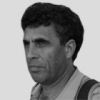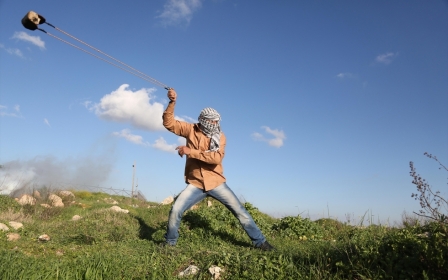Greater Jerusalem: Israel's failed project

By its name, the new Movement For Saving Jewish Jerusalem sounds like another Israeli right-wing movement, bordering on anti-Arab propaganda. Its logo, a lion (symbol of Jerusalem) surrounded by David's Shields, sends the same massage. Jerusalem should be a Jewish-only city. Palestinians are not welcome.
Yet this recently founded movement is headed by prominent figures in what is usually referred to as the Israeli Peace Camp: Haim Ramon, ex-minister for labour and Ehud Olmert's Kadima; Amy Ayalon, ex-contender for the leadership of the Labor party, and several others. The current leader of Labour, Isaac Herzog, gave his blessing as unilateral separation from the Palestinians became the hottest product which the Israeli centre-left is trying to sell its public.
The basic idea presented by this movement is to build a new wall separating several of the Palestinian neighbourhoods in East Jerusalem, annexed after the Israeli occupation in June 1967, from the heart of the city. Israel will transfer control over these neighborhoods to the Palestinian Authority, and its approximately 200,000 residents would lose their status as Israeli temporary residents which allowed them access to Jerusalem.
Israel will retain its control over the huge Jewish neighborhoods it has built in areas it had annexed in 1967 in the northern, eastern and southern outskirts of Palestinian Jerusalem and also over the Old City and the Palestinian neighborhoods around it.
Such a move, according to the movement's initiators, would strengthen security in the city, will save Israel two or three billion shekels (500 to 750 million dollars) on social benefits paid to the Palestinians residents in these mainly poor neighborhoods and above all, would make Jerusalem Jewish again. While today 37 percent of Jerusalemites are Palestinians (307,000 out of 829,000), their ratio will fall to just 20 percent. Jewish Jerusalem will be saved.
There are three things the Jewish public in Israel is in favour of, explained Ramon, the political father of this idea, in a recent interview: "[not] giving money to Arabs, it wants its state to be Jewish and it wants to have security. If our plan doesn’t go through, Jerusalem will become an Arab city with a Palestinian majority," he warned.
This new partition plan, if implemented, will deal a hard blow to those Jerusalemite Palestinians who will find themselves on the wrong side of the wall. They will be cut off from Jerusalem in which most of them work or study, and they will be deprived of their Israeli residency status which allowed them relative freedom of movement and a higher standard of livings than their fellow Palestinians in the West Bank. Above all, it will deny them access to the Old City and Haram a-Sharif, stripping them of their Jerusalemite identity.
The authors of initiative admit that they are not looking for Palestinian consent for their ideas - neither from the Palestinian leadership nor from the Palestinian residents of the neighbourhoods bound to be transferred to the PA. Ramon justifies this approach by rightly pointing that "their annexation was a unilateral move too". He just wants to stick to this old-times Israeli tradition in which the Palestinians are not to be consulted about their own fate.
This plan has very slim chances of being implemented. Binyamin Netanyahu's right-wing government will never allow any retreat from the already enshrined borders of Greater Jerusalem decided in 1967. The Palestinians will obviously oppose such a move, and legally it will not be easy to coerce hundreds of thousands of Palestinians to give up their status as Israeli residents and accept a Palestinian one (which, by the way, will not mean much as Israel will maintain its military control over these areas).
The failure of the Jerusalem plan
Yet this plan, and its endorsement by large parts of the Jewish Israeli public according to polls allegedly conducted by Saving Jewish Jerusalem, represents a much wider phenomenon: the crumbling of Israel's biggest colonising project since 1967 – the Judaisation or rather the Israelisation of East Jerusalem.
Right after it occupied the West Bank in June 1967, Israel annexed not only the Jordanian part of Jerusalem but also small towns and villages around it, a total of 70 square kilometers with 66,000 Palestinians, 24 percent of the total population of "united" Jerusalem back then.
Through a huge project of building new Jewish neighbourhoods on these newly annexed areas, Israel believed it could achieve two goals: to flood Jerusalem with Jews and thus reduce the Palestinian population into a tiny minority and to separate Palestinian Jerusalem from its hinterland in the West Bank, whether it is Ramalla to north, Bethlehem to the south or Jericho to the east.
This ambitious project did turn Jerusalem, an almost peripheral city before 1967, to Israel's biggest city, with more than 800,000 residents compared to 450,000 in Tel Aviv. Over 250,000 Israelis live in the neighborhoods built over the grin line. But It also made Jerusalem into one of Israel's poorest cities. The city overexpanded, services got worse, the city centre declined slowly and there were not enough jobs in the private sector.
The more wealthier and secular sectors started moving out. Ultraorthodox Jews (Haredim), who mostly preferred studying in a yeshiva than participating in the city's economic life, moved in. Today the ultraorthodox represent more than a third of the Jewish population in the city, and more than half of the Jews under 18 years old.
As a result the migration out of Jerusalem to other cities is the highest in Israel. Only last year, Jerusalem received 10,000 newcomers, while some 17,000 left the city. This negative trend has been going on for years. The Jerusalem Institute for Israeli Studies estimates that between 2007 and 2011, the net Jewish migration out of the city was 33,000.
Worse. Despite indefatigable efforts to put obstacles in the way of the Palestinian population in Jerusalem, from limiting their building rights to depriving them of their status of temporary residents for technical reasons (they had to prove that their "centre of life" is in Jerusalem), this community managed to grow steadily, both in numbers as well as in proportion among the city residents. From 66,000 Palestinians in 1967 to 307,000 today, from 24 percent to 36 percent of the population.
Even the building of the separation wall, which put a barrier between Jerusalem and its Palestinian hinterland starting from 2004, did not stop this process. It made life miserable for many Jerusalemite Palestinians and dealt a blow to their businesses, as the city ceased to be the economic centre of the West Bank, but they preferred to stay put.
The separation wall, which spreads over more than 120 kilometres around the city, did not even make life safer for Jerusalemites, Jewish and Palestinian a like. Since the murder of the Palestinian boy Muhammad Abu Khdier on July 2014, the city has rarely known a moment of quiet. The current way of violence, which began almost six months ago, erupted in Jerusalem, starting from tensions around Haram a-Sharif/Temple Mount and spreading along the city. The Israeli capital is the least safe city in the country.
Despite the enormity of its project in Jerusalem, it seems that Israel is unable either to swallow East Jerusalem or to give it up. The recent initiative by Saving Jewish Jerusalem looks like a desperate attempt to roll back the wheel. But it is probably too late. The dream of a greater Jewish Jerusalem has crumbled. Its ruins are here to stay.
- Meron Rapoport is an Israeli journalist and writer, winner of the Napoli International Prize for Journalism for a inquiry about the stealing of olive trees from their Palestinian owners. He is ex-head of the News Department in Haaertz, and now an independent journalist.
The views expressed in this article belong to the author and do not necessarily reflect the editorial policy of Middle East Eye.
Photo: A female Palestinian demonstrator uses an axe to try and destroy a part of the Israeli controversial separation wall separating the West Bank city of Abu Dis from east Jerusalem, during clashes with Israeli security forces, on 2 November, 2015 (AFP).
Middle East Eye propose une couverture et une analyse indépendantes et incomparables du Moyen-Orient, de l’Afrique du Nord et d’autres régions du monde. Pour en savoir plus sur la reprise de ce contenu et les frais qui s’appliquent, veuillez remplir ce formulaire [en anglais]. Pour en savoir plus sur MEE, cliquez ici [en anglais].





